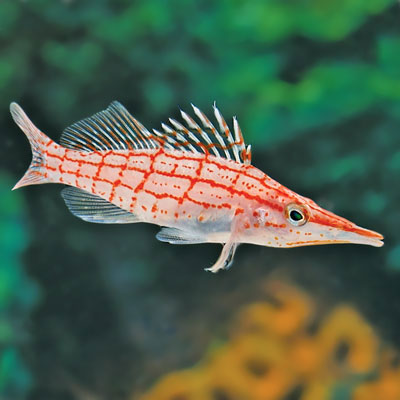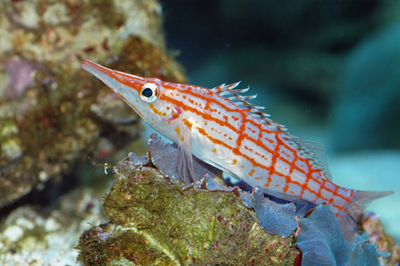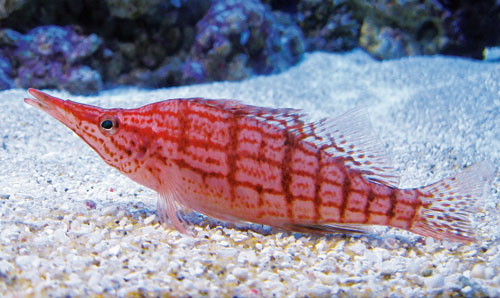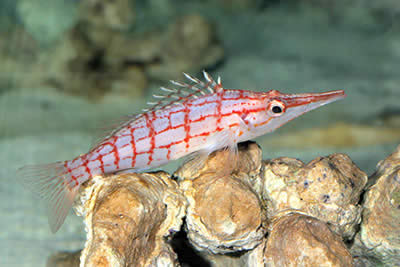
Oxycirrhites typus
FAMILY
Cirrhitidae
TAXONOMY
Oxycirrhites typus Bleeker, 1857, Ambon Island, Moluccas, Indonesia.
OTHER COMMON NAMES
German: Gestreifter Schьtzenfish; Japanese: Kudagonbe.
PHYSICAL CHARACTERISTICS
Body slender, with an elongated snout; body whitish in color
with a tartanlike pattern in red along body, snout, and dorsal
fin; males larger than females within mating groups. To 5.1 in
(13 cm).
DISTRIBUTION
Red Sea east to Panama; southern Japan south to New Caledonia.
HABITAT
Usually deep slope or wall habitats in seaward coral or rocky
reefs, passes, and lagoons; shallow rocky reefs in southern Baja
California Sur, Baja Peninsula, Mexico, and occasionally found
on shallow coral reefs elsewhere, particularly in areas of upwelling.
Otherwise, more common in deeper reef habitats.
Usually found in gorgonians (sea fans) and black corals.
BEHAVIOR
Occurs singly or in facultatively monogamous pairs on gorgonians
and black corals. Will have a haremic mating system if
the gorgonian or black coral is large or if others are close by.
FEEDING ECOLOGY AND DIET
Plucks small benthic and planktonic crustaceans with its long
snout.
REPRODUCTIVE BIOLOGY
Protogynous hermaphrodites. Paired courtship and pelagic
spawning just prior to or after sunset. If a male has a haremic
mating group, he will move back and forth between females to
court them until they spawn. Eggs and larvae are pelagic. Eggs
are spherical, about 0.027 in (0.69 mm) in diameter, and hatch
after 15 hours incubation at 80.6°F (27°C). The yolk sac is
large, and the jaws and eyes undeveloped. Pigmentation develops
with absorption of the yolk. Larvae are elongate and compressed
laterally. Possess a gas bladder that is lost in adults.
Specializations for pelagic life include serrations on the preopercle,
a chin barbel (which disappears with growth), and the
presence of cirri on the spinous dorsal fin membrane and also
on the anterior nostril.
CONSERVATION STATUS
Not listed by the IUCN. Not commonly seen, despite its wide
DISTRIBUTION
, and population levels likely to be limited by available
micro
HABITAT
. The collection of black corals for the jewelry
trade and gorgonians for the ornamental trade poses a
threat, as do unregulated harvests by the aquarium trade.
SIGNIFICANCE TO HUMANS
A highly prized aquarium species.
Photo Gallery of - Longnose hawkfish





 Animalia Life
Animalia Life